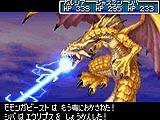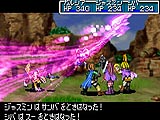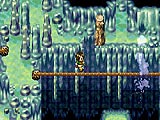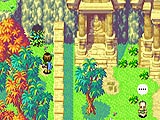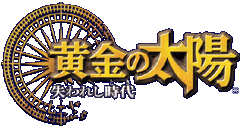
| Platform: Game Boy Advance | Publisher: Nintendo of America |
| Previewer: Stephen Harris | Developer: Camelot Software Planning |
| Preview Update: none | Expected Release: First Quarter 2003 |
|
Preview 7/13/02 Golden Sun for the Game Boy Advance was a complete surprise, emerging as one of the most successful RPGs of 2001. Camelotís role-playing wonder merged great graphics, an engaging story and addictive gameplay; illustrating that the GBA was a true RPG contender. Though the game was impressive, Golden Sun concluded with a monstrous cliff hanger. Camelot left their audiences shocked and just a little disappointed, but inevitably the sequel was announced. Golden Sun: The Lost Age promises to captivate fans of the original and indoctrinate another generation of portable RPG fans.
From the limited information available on this highly anticipated sequel, The Lost Age appears to borrow a page from Shining Force III, Scenario 2 with the continuing tale told from the oppositionís perspective. Golden Sun told the story of Isaac and his band of childhood friends: fellow psynergists who journeyed across the continent to stop dark forces from lighting the four elemental lighthouses that would bring calamity. The Lost Age is the continuing adventures of the psynergist Felix (known as Garcia in the Japanese release), the youth who was thought drowned and dead during the first few hours of Golden Sun, only to return to threaten the world alongside the villains Saturos and Menardi. Accompanying Felix is his sister Jenna (Jasmine), the feisty fire psynergist who once accompanied Isaac, only to become his enemy because of her faith in her brother. Even the sister of the cold and calculating Menardi, along with a fellow clansman of Saturos, will become a part of Felixís troupe. In The Lost Age, friend has become foe and Camelot promises that every assumption made about the motives and allegiances in the first Golden Sun will be drawn into question. The mysterious Shiba returns, but to what end? Alex, the water psynergist who betrayed his oath to protect the Mercury Lighthouse in the original game will also make an appearance, but will his motives be more clearly understood? Many questions left unresolved in Golden Sun will be answered, but gamers may find that some of these solutions will present even deeper, darker riddles.
RPG fans who have played the original Golden Sun will be delighted to find that The Lost Age is equally attractive, if not more so. The game is drawn in colorful 2D sprites with vibrantly detailed backgrounds. The fully rotateable overworld map from the original game returns, bearing a strong resemblance to Final Fantasy IIIís Mode 7 field map. The battle sequences are reminiscent of Camelotís Saturn RPG, Shining the Holy Ark, with pre-rendered character sprites, fluid animation, and copious particle effects. The elusive creatures known as the Djinn will also return to the game with even more intensity.
Camelot has reenlisted the talented former Wolf Team musician, Motoi Sakuraba, for another acoustic extravaganza. His works include the scores for Shining Force III, Shining the Holy Ark, Star Ocean 2, and Valkyrie Profile among others. Sakuraba-sanís flair for sweeping orchestral pieces with heavy percussion and his love of the keyboard will no doubt enrich an already promising soundtrack. His work on the original Golden Sun was impressive and Camelotís decision to foster musical continuity was a wise one.
Golden Sun: The Lost Age will feature random encounters and classic turn-based gameplay with many of the features that made Golden Sun successful. The Djinn, elemental spirits that are the keys to monster summoning, return once again. For those who follow RPG summoning lore, the Djinn system is similar to the esper system pioneered in Final Fantasy III. The Djinn are creatures that can be equipped onto a character, giving them access to Djinn powers, a complement of elemental spells as well as altering that characterís statistics. Casting several Djinn powers will allow the party to summon forth great elemental manifestations into battle. As more Djinn are found, characters can equip several at a time, making for an infinite number of combinations. This mixing and matching of elemental spirits give rise to unique spells and summons as well as changing the characterís class. These concoctions result in new special attacks and additional attribute bonuses. Gamers will have to be cautious; as the original Golden Sun emphasized Djinn compatibility with certain characters, The Lost Age will feature even more selective Djinn to tinker with. Only by experimenting will gamers discover the more potent abilities hidden within the characters.
The original Golden Sun featured a plethora of puzzle-based dungeons that players solved using the psynergy powers of the party. The Lost Age will continue that tradition introducing more abilities with which to manipulate the surroundings. While no further information is available regarding specific character psynergy abilities, the mind powers from the first game will probably be included.
The battle mode will make a return in Golden Sun: The Lost Age, allowing RPG fans to make combat a bit more personal via the link cable (sold separately). Fans of the original game will be delighted to know that the mysterious save file that they had earned upon completion of Golden Sun will be used in Golden Sun: The Lost Age. The data can be transferred via link cable or manually via an extremely long code sequence. The file allows information such as character statistics, number of Djinn collected, etc. to be integrated into The Lost Age, though the extent of the effect is unknown at this time. While this feature is native to the Japanese version, no information about this aspect of the North American release is available.
Golden Sun redefined the concept of a RPG on a portable console, and The Lost Age promised to continue that tradition with impressive graphics, immersive gameplay, and an even more intriguing storyline. Based on the composerís pedigree, the soundtrack should also be remarkable. Released in Japan on June 28, 2002 to critical acclaim, and slated for an early 2003 release in North America, Golden Sun: The Lost Age will be met with much enthusiasm. |
|

